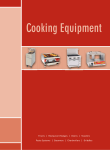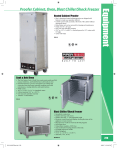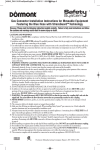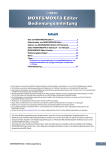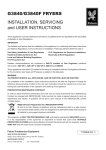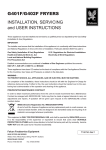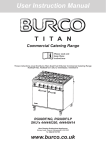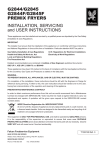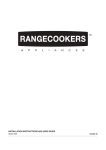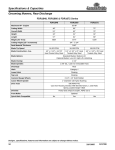Download Recommended Operating Instructions: Cleaning Behind Equipment
Transcript
WARNING Please read the following instruction booklet carefully. Failure to fully read instructions and follow the cautions and warnings could result in severe injury or death. Recommended Operating Instructions: Cleaning Behind Equipment I. Disconnecting the Gas Line 1) Turn off the equipment. 2) Carefully pull the equipment away from the wall, stopping when the restraining cable is taut. 3) Shut-off the gas supply by turning the lever on the gas ball valve (located off the main manifold line) to the “off” position. Unplug any electrical cords. 4) Disconnect the gas line by pulling back the sleeve of the quick-disconnect coupling. Be careful not to drop the coupling on the floor, which may damage the unit. 5) Detach the snap-hook of the restraining cable. 6) Carefully pull the equipment away from the wall. 7) Clean behind the equipment, making sure no foreign substance, grease, cleaning solution or dirt enter the quick-disconnect coupler or gas line. II. Reconnecting the Gas Line 1) Reattach the quick-disconnect coupling by inserting the plug (nipple) end into the coupler. 2) Reattach the restraining cable. 3) Reattach any electrical cords. 4) Turn the lever on the gas ball valve to the “on” position. 5) Carefully push the equipment back toward the wall, taking great care so that the gas connector is not twisted or kinked in a severe angle. Be sure that the gas connector is not damaged or crushed by the equipment rolling over it. 6) If required, relight the pilot light. Turn the equipment on. Dormont Engineering Support The Dormont Engineering team is available to help with the design and layout of foodservice equipment installations. We can design the proper gas connection to work with your equipment and kitchen requirements. Dormont has worked with consultants, national chains, and equipment manufacturers to solve tough gas installations problems. The previous CAD drawings are just a few examples of the kind of technical support we can provide. Contact one of our Customer Service Specialists at 1-800-DORMONT (367-6668), for details. Returns No returns are to be made to Dormont Manufacturing Company without first obtaining a return authorization number. Absolutely no returns will be accepted or credited without this prior approval. Returns may be subject to a 25% restocking charge plus any transportation charges incurred. 8 6015 Enterprise Drive • Export, PA 15632 USA (724) 733-4800 • FAX (724) 733-4808 • 1-800-DORMONT (367-6668) • www.dormont.com DM-153A, Rev. 8, 8/10 Dormont Safety System Gas Connector Installation Instructions TM Warning Please read the following instruction booklet carefully. Failure to fully read instructions and follow the cautions and warnings could result in severe injury or death. CAUTIONS AND WARNINGS 1. The installation MUST BE in compliance with the National Fuel Gas Code (ANSI Z223.1 - latest edition) and all local gas installation codes. 2. Installation and testing MUST BE performed by qualified personnel. Ensure that the gas supply and all the appliance control knobs are turned off before connecting to the gas supply. 3. Gas outlet shall be in same room as appliance and the connector must not be concealed within or run through any wall, floor, or partition. Flexible gas connections shall not come into contact with surfaces at temperatures in excess of 110°C (230°F), sharp edges or wiring. 4. The final assembly shall be tested for leaks. CAUTION: Open flame or other sources of ignition shall not be used for this purpose. Leak test solutions may cause corrosion. WATER RINSE AFTER TEST. To check gas supply piping system for leakage, see National Fuel Gas Code Z223.1 latest edition. If odor of gas is detected, turn off the gas to the appliance and have a qualified professional correct the source of the leak. 5. WARNING: STRONG CLEANING SOLUTIONS OR CHEMICAL SUBSTANCES MUST NOT COME IN CONTACT WITH THE CONNECTOR. These may include acids, solvents, fluxes with zinc chloride, or other chlorinated chemicals. In case of contact, rinse down the connector with water and dry thoroughly. 6. An accessible manual shutoff valve must be installed at the outlet of the gas supply piping system upstream of the connector. 7. Contact with foreign objects, wiring or substances shall be avoided. 8. Avoid movement after installation on fixed appliances. 9. Bending and flexing of connectors on moveable appliances (e.g. those factory equipped with casters) should be limited to pulling and pushing the appliance in or out for cleaning or maintenance. 10. Connectors are for use only on piping systems having fuel gas pressure not in excess of 1/2 psi (3.5 kPa) for the US and 1 psi (7kPa) for Australia. Flexible connections are suitable for use with 1st, 2nd and 3rd family gases only on piping systems operating at a pressure not exceeding 50 mbar. 11. All parts of the flare union, supplied with the connector, must be utilized and no attempt will be made to assemble union flare nuts directly to IPS pipe threads. 12. DO NOT REUSE FOR ANOTHER APPLIANCE OR AT ANOTHER LOCATION. 13. In addition to the main gas supply shut-off valve, an approved accessible manual gas shut-off valve MUST BE installed upstream of the gas connector (within 6 feet of the equipment it serves). Each piece of equipment must have its own shut-off valve. The quick-disconnect coupling is NOT TO BE USED as the primary gas shut off. 14. WARNING: THE QUICK-DISCONNECT MUST BE INSTALLED SO THAT THE GAS ENTERS THE COUPLING HALF AND EXITS THE NIPPLE HALF. YOU MUST FOLLOW THE FLOW DIRECTION ARROWS THAT ARE PERMANENTLY MARKED ON THE COUPLER. 15. NEVER INSERT screwdrivers, probes, etc. into the quick-disconnect coupling. The valve seat can be damaged or forced off center. 16. The connector shall not be kinked, twisted, or torqued when installed. 17. DO NOT USE pipe dope, teflon tape or any other sealing compound in flare seat of gas connector. 18. Make sure that all fittings are tightened properly. When installing the connector, two (2) 14 inch crescent wrenches (minimum size) are recommended as installation tools. 19. Adequate means must be provided to limit the movement of castered appliances. A restraining device is REQUIRED for all types of moveable gas appliances. (ANSI Z223.1 & ANSI Z21.69). 20. The recommended restraining device for castered appliances is Dormont’s Restraining Device. Installation instructions for this Dormont product are part of this booklet. This “restrainer” should be inspected as part of the regular maintenance and safety procedures. Restraining cable MUST BE connected at all times when appliance is in use. You must follow the instructions on page 4. 21. When installing an equipment line-up with dual-fed front manifold gas inlets, DO NOT use a quick-disconnect coupling. 22. For installations that require greater mobility, Dormont SwivelMAXTM gas connector assemblies are recommended. 23. Appliance MUST BE disconnected prior to maximum movement. Warning: DO NOT OVEREXTEND the gas connector assembly. When moving equipment (for cleaning, maintenance, etc.), you must follow the instructions on page 8. Dormont Manufacturing Company Export, PA 15632 USA 1 INSTALLATION INSTRUCTIONS (FIGURE 1) 1. 2. 3. 4. 5. 6. 7. 8. Before proceeding, CAREFULLY read this full set of instructions, including the CAUTION AND WARNINGS section and the INSTALLATION RIGHTS AND WRONGS section of this instruction booklet. The manual gas shut-off ball valve (B), located in the gas manifold line (A), must be in the fully-closed (off) position. If there is no gas shut-off valve in the manifold line, the main gas supply line valve (not shown) must be turned off. DO NOT CONTINUE unless the gas is turned off. Remove the gas connector and contents from the bag or box. The location of the two connection end points for the gas appliance connector - the gas supply line and the equipment stub-out – can vary greatly. It is not possible to show every possible installation combination. These instructions include several examples of common Drawing 1 - offset installations. The installer must always take great care to ensure that the connector is not kinked, twisted or torqued when installed and that the end fittings of the connector are not subjected to sharp bends. (Please refer to Installation Rights and Wrongs). For installations that may result in a sharp bend, Dormont SwivelMAXTM gas connectors are recommended. It is recommended that the main gas supply manifold be located 30''- 42'' off the ground. There should be pipe tees pointed in the downward direction. To facilitate moving equipment as close to the wall as possible, the two ends of the Dormont gas connector should be offset to the side from each other. (+/ – 3'' offset recommended) see drawing 1. Each piece of equipment MUST have its own approved manual shut-off valve off of the main gas supply line. If there is not an accessible manual gas shut-off valve for each piece of equipment, make sure that the gas has been shut off at the main gas shut-off valve for each piece of equipment before continuing. MANUAL SHUT-OFF VALVE INSTALLATION – Female x Female valve ends a. If the pipe tee is a male thread: Apply thread tape or sealant to accessible pipe threads located at the gas supply line. Thread the gas shut-off ball valve onto the male iron pipe and tighten wrench tight. Locate ball valve as close as you can to the manifold leaving enough clearance to turn on and off. Preferred valve position is vertical. (see Figure 1). b. If the pipe tee is female: Apply thread tape or sealant to the threads of a pipe nipple (not supplied/preferred length is three inches). Thread pipe nipple into female pipe tee off main gas line. Then thread the shut-off valve onto the pipe nipple and tighten wrench tight. OPTION 1 FIGURE 1 SnapFastTM Device Installed at the Appliance This installation method, commonly used in North America, shows the quick-disconnect coupling attached at the appliance side. The nipple MUST always be on the appliance side, attached to the appliance stub-out. This enables the operator to move the equipment away from the wall in an equipment line-up and safely disconnect the gas connector from the back side of the appliance. A Gas Supply Line (Gas Manifold) E GAS GAS FLOW DIRECTION B Gas Shut-Off Ball Valve/Valve Iron Pipe C Gas Connector TM D SnapFast Quick-Disconnect E 90° Street Elbow F Appliance Male Stub-Out G Restraining Device H Female Adapter I Flare Nut J Quik-Disconnect Coupling (female) K Quik-Disconnect Nipple (male) Operating Instructions To Connect: Push nipple straight into coupler until sleeve snaps forward against retaining ring. Open shut-off valve to turn on gas. To Disconnect: Close shut off valve to turn off gas. Retract sleeve and pull out nipple.Important: Coupling is not to be used as the primary shut off. 2 GAS FLOW DIRECTION Warranty Certifications Warranties and Remedies a. Warranty. Seller warrants to Buyer that it holds and will pass marketable title to the commercial gas connectors sold hereunder. Seller further warrants to Buyer that Seller’s commercial gas connector will be free from defects in material and workmanship causing gas leakage during the life of the equipment to which the commercial gas connector is originally connected or installed. Seller warrants to Buyer that the items and components manufactured by Seller other than commercial gas connectors will be free from defects in material and workmanship for a period of five (5) years from tender of delivery to Buyer. For items not manufactured by Seller, the only warranty extended is that of the manufacturer or suppliers, if any. b. Exclusions and Conditions. Seller's obligations with respect to the express warranties and remedies contained herein are conditioned on the following: (i) Seller’s liability and Buyer’s exclusive remedy is expressly limited to Seller’s replacement of the defective gas connector or other goods at Seller’s cost (excluding labor and freight); it being understood such replacement will be made only upon return of the defective item in accordance with Seller’s shipping instructions and return authorization and subject to Seller’s inspection; (ii) Buyer shall not assign its rights under these express warranties and any attempted assignment shall render such warranties, but not any disclaimers or limitations, void and the goods shall be sold AS IS; and (iii) all commercial gas connectors and other goods shall be carefully inspected for damage by Buyer upon receipt, be installed by individuals trained and certified as professionals with respect to such installation, and be installed, used, repaired and maintained by Buyer in accordance with local codes or regulations, standards set by American National Standard Institute and/or American Gas Association Standards. The commercial gas connectors and other goods shall be warranted in conjunction with the original installation only and the express warranties and remedies contained herein shall not apply to, and shall be void and of no further force or effect upon, damage and/or failure of the commercial gas connectors and other goods caused by or resulting from shipping; improper or unauthorized handling, installation, alteration or repair; misuse, abuse or other occurrences or conditions other than normal use thereof; application or conformity to local codes or regulations not previously made known to Seller; or accident or other casualty. Disclaimer of Implied Warranties Seller gives no warranties except those expressly contained herein. Seller disclaims all other warranties implied by law, usage of the trade, course of dealing or course of performance including, but not limited to, the implied warranties of merchantability and fitness for a particular purpose. Conditions Limitations of Liability. The following limitations of Seller’s liability are acknowledged by the parties to be fair and reasonable and shall apply to any act or omission hereunder, and to any breach of this contract of which these terms and conditions form a part. Certifications USA Canadian Standards Association International ANSI Z21.24 — Connectors for Gas Appliances ANSI Z223.1 — National Fuel Gas Code-National. Fire Prevention Association — N.F.P.A. #54 Connectors for Moveable Appliances. Connectors for outdoor gas appliances and manufactured homes ANSI Z21.69 — ANSI Z21.75 — ANSI Z21.41 — City of New York — Approved by the Commonwealth of Massachusetts Board of State Examiners of Plumbers & Gas Fitters. (36'' maximum length) CANADA Canadian Gas Association International CSA - 6.10 — CSA - 6.16 –– CSA - 6.9 –– CSA - B149.1 UK CORGI BELGIUM Connectors for Gas Appliances. Connector for Moveable Appliances. Quick-disconnect devices for use with gas fuel appliances. Natural Gas and Propane Installation Code. Certified to BS 669-2: 1997 License # KM39643 Dormont Hoses have been Tested By BSI, and Meet with and Exceed the Essential Safety and Performance Requirements of BS669 Part 1 and Part 2. Technical Bulletin 54 Association Royale Des Gaziers Belges Societe Technique De L’Industrie Du Gaz En Belgique A.S.B.L. Test reports LDG/95/2166-2170 December 1995 AUSTRALIA Disclaimer of Damages In no event shall seller be liable for special, indirect, consequential or incidental damages, whether arising under contract, warranty, tort, negligence, strict liability or any other theory of liability. Such damages include but are not limited to loss of profits, loss of use of the goods, damage to property, and claims of third parties. Some states do not allow the exclusion or limitation of incidental or consequential damages, or any limitations on how long an implied warranty lasts, so the above exclusion or limitation may not apply to you. This warranty gives you specific legal rights, and you may also have other rights which vary from state to state. Quick-Disconnect devices for use with gas fuel appliances. Design certified to ANSI/U.L. 567, Pipe Connectors for Flammable and Combustible Liquids and LP-Gas. For use with natural gas and propane. National Sanitation Foundation Criteria C-2 special equipment. MEA #98-83, 99-84, 100-83 AS 1869-1991 Hose and hose assemblies for liquefied petroleum gases (LPG), natural gas and town gas. DENMARK Danish Government Gas Institute type-examination certificate no. 3419-3422 Notice and Time of Claim (i) Buyer agrees to check and inspect all products against shipping papers and for damage or shortage upon receipt of goods at destination; (ii) Every claim for loss, damage in transit, or other cause visible upon inspection shall be made with carrier. Claims for shortage must be made within five (5) days of receipt; (iii) The parties expressly waive the statute of limitations and agree that any legal proceeding for any breach of this contract shall be waived unless held within two (2) years after the accrual of the cause of action therefor. 7 Installation Rights and Wrongs Wrong Avoid sharp bends and kinks when pulling equipment away from wall. Maximum pull will kink ends, even if installed properly, and reduce connector life. Right Minimum pull of equipment away from wall permissible for accessibility to Safety Quik-Disconnect. WRONG RIGHT Sharp Bends The correct way to install metal hose for vertical traverse is with a single, natural loop. Avoid sharp bends that strain and twist the metal hose to a point of early failure at the coupling. WRONG RIGHT Fatigue Maintain the minimum or larger bending diameter between the couplings creates double bends causing work fatigue at the fittings. Note: Appliance must be disconnected prior to maximum movement. Minimum movement is acceptable to leave connected. Nominal connector I.D. inches 1/2” 3/4” 1” 1 1/4” WRONG RIGHT Twisting Couplings and hose should be installed in the same vertical plane. Failure to do so causes torsional twisting and undue strain causing premature failure. WRONG RIGHT Self-Draining In all installations where “self-draining” is not necessary, connect metal hose in a vertical loop. Do not connect metal hose horizontally unless “selfdraining” is necessary, then use support on lower plane. Note: Never insert such objects as screwdrivers, probes, etc. into the Safety QuikTM Valve. The valve’s seat can be damaged or forced off center. Note: Restraining Device is mandatory for all types of moveable gas appliances. CONNECTOR CAPACITY Straight Length Capacity - BTU per Hr (w) 0.64 Sp Gr 1000 BTU per Cu. Ft. Gas at 0.5 in. Water Column Pressure Drop 2ft. 150,000 290,900 581,800 1,075,000 4ft. 106,000 215,000 442,700 817,500 6ft. 86,600 173,900 347,800 634,000 NOTE: When using 0.2 water column pressure drop, capacity can be determined by multiplying the figures above by 0.632. For capacities at conditions other than noted, contact your servicing gas supplier. Nominal connector I.D. inches 1/2” 3/4” 1” 1 1/4” NOTE: 6 CAPACITY WITH QUICK-DISCONNECT DEVICE Straight Length Capacity - BTU per Hr (w) 0.64 Sp Gr 1000 BTU per Cu. Ft. Gas at 0.5 in. Water Column Pressure Drop 2ft. 4ft. 87,000 232,000 414,000 699,000 68,000 180,000 334,000 541,000 Capacity was determined under test conditions specified by ANSI Z21.69 6ft. 55,000 139,000 279,000 419,000 I I NSTALLATION NSTRUCTIONS (CONT.) 9. WARNING: The quick-disconnect coupling (D) MUST BE oriented so that the gas enters the female (valved) coupling half and exits the male nipple half. FOLLOW the flow direction arrows permanently marked on the coupler. 10. NOTE: There are two options for the orientation of the quick-disconnect couplings: OPTION #1, quick-disconnect at the appliance. OPTION #2, quick-disconnect at the piping system. WARNING: Our gas appliance connector assembly is supplied with the threads of the quick-disconnect tightened into the gas connector. This process is implemented in the factory to facilitate an Option 1 installation. 11. OPTION 1: Quick-disconnect attached at the appliance side. A. Gas Supply Side: Apply thread sealant (pipe dope) or thread tape to the valve nipple. Thread the gas connector’s adapter (H) end onto the pipe nipple extending from the gas shut-off valve and tighten. B. Tighten the flare nut of the gas appliance connector (I) to the flare end of the adapter (H). Tighten with wrench. C. Appliance Side: Apply thread sealant (pipe dope) or thread tape to the appliance’s male stub-out (F) and thread street elbow (E) onto male stub-out. D. The location of both the equipment stub-out and the tees for the gas supply line manifold can vary greatly. E. Apply thread sealant (pipe dope) or thread sealant to male street elbow (E)threads. F. Separate quick-disconnect coupling male end, or nipple (K) off of the female end, or coupling (J). Thread the male nipple (K) onto the street elbow (E) of the appliance and tighten. Note: The quick-disconnect MUST BE ORIENTED so that the gas enters the coupling half and exits the nipple half. Installation personnel MUST follow the flow direction arrows permanently marked on the coupler. G. Connect quick-disconnect female coupling (J) to the male nipple (K). H. Check tightness of all connections. Leak test in accordance with accepted testing procedures. I. After installation of the connector, carefully push the appliance back to its normal operating position and check that the connector is not kinked, over bent, or caught under the equipment casters. 12. *OPTION 2: Quick-disconnect attached at the gas supply line side. A. WARNING: If you decide to select an Option 2 installation (quick-disconnect at the gas supply side), the quick-disconnect must be disassembled from the connector. The female coupler part of the quick-disconnect coupling must be upstream and attached to the gas supply. B. Appliance Side: Apply thread tape or sealant to the appliance’s stub-out (F) and thread street elbow (E) (supplied) onto stub-out. Tighten. C. Apply thread tape or sealant to the street elbow (E) threads and thread the connector’s adapter (H) end onto the street elbow (E). Tighten the adapter to the street elbow. Thread connector flare nut onto the flare end of the adapter. Tighten with wrench. D. Gas Supply Side: Separate the quick-disconnect female coupler (J) from the male nipple (K). Apply pipe dope or thread tape to valve nipple. Thread the quick-disconnect female coupler onto threads of the pipe nipple from the gas shut-off valve. E. Connect quick-disconnect male nipple (K) to the female coupler (J). F. Check tightness of all connections. Leak test in accordance with accepted testing procedures. G. After installation of the connector, carefully push the appliance back to its normal operating position and check that the connector is not kinked, over bent, or caught under the equipment casters. FIGURE 2 OPTION 2* SnapFastTM Device Installed at the Gas Supply This installation method, commonly used in Europe, shows the quickdisconnect coupling attached at the gas supply side. The coupler MUST always be on the supply side, attached to the supply side piping. This enables the operator to move the equipment away from the wall in an equipment lineup and safely disconnect the gas connector from the gas supply line. A B House Pipe Inlet D Gas Connector C E GAS GAS FLOW DIRECTION E F Full Port Gas Ball Valve SnapFast Disconnect Coupling TM 90° Street Elbow G Restraining Cable H Female Adapter I Flare Nut J Quik-Disconnect Coupling (female) K Quik-Disconnect Nipple (male) Appliance Male Stub-Out *This installation method is in compliance with BS669: Part 2 and BS6173. 3 Restraining Cable Installation Instructions Restraining Cable Installation THIS RESTRAINING DEVICE MUST ALWAYS BE RECONNECTED WHEN THE APPLIANCE IS IN SERVICE The restraining device should be disconnected for movement, such as, servicing or cleaning, only after gas has been shut off and the connector has been disconnected. Reconnect retsraining cabel before reconnecting the gas connector and moving back to its original position. RESTRAINING CABLE: 1. Restraining Device should be installed parallel (in line with the gas appliance connector.) 2. Attach the staple bracket (C) to a stud in the wall, using the four 1'' #10 screws (D) and the plastic anchors (E) if needed. 3. Locate a structural area (frame) on the rear side of the equipment that is in line with the wall attachment. Drill a 1/4'' diameter hole. Use caution when drilling hole, so that internal components are not damaged. 4. Thread the hex nut (G) and a washer (I) onto the eye-bolt (F). Slide one washer onto the nut. Slide the eye-bolt through the drilled hole and place a washer (I) and the nylon lock nut (H) onto the eye-bolt on the inside frame of the equipment and tighten securely. 5. Attach one of the snap hooks (B) to the staple bracket on the wall (Step 2 above) and the other to the eye-bolt (Steps 3 and 4 above). Note: For adjustable restraining devices, the cable is manufactured to be shorter than the length of the gas connector. A - Restraining Cable with B - Two Snap Hooks C - Staple Bracket G - 1/4'' Hex Nut D - 1'' #10 Screws (4) H - 1/4'' Nylon Lock Nut E - Plastic Anchors (4) I - 1/4” x 1 1/4'' Washers (2) F - Eye-Bolt WRONG Set the length of the restraining device so that the connector is not kinked when the restraining device is fully extended. Installation Examples VERTICAL LOOP WALL: Medium-Level Gas Supply EQUIPMENT: Rear High Inlet Connection RECOMMENDATION: Dormont Double SwivelMAXTM Kit Installation Model #1675 KIT2S 48 HORIZONTAL LOOP WALL: Floor Level Gas Supply EQUIPMENT: Rear Low Inlet Connection RECOMMENDATION: Dormont Single SwivelMAXTM Kit Installation Model #1675 KITS 48 4 RIGHT SAFETY QUIKTM Installation COMBINATION LOOP WALL: High Level Gas Supply EQUIPMENT: Rear Low Inlet Connection RECOMMENDATION: Dormont Double SwivelMAX Kit Installation Model #1675 KIT2S 48 WALL: High Level Gas Supply EQUIPMENT: Rear High Inlet Connection RECOMMENDATION: Dormont Safety Quik QD/Valve with Double SwivelMAX Fittings SwivelMAXTM Instruction DESIGN CERTIFIED FOR USE WITH DORMONT GAS CONNECTORS ONLY 1. 2. 3. 4. 5. 6. 7. 8. Do not conceal swivel within or run through walls, floor, or partitions. For use on piping systems having fuel gas pressures not exceeding 1/2 psig. Install per Installation Instructions included with gas connector. Install downstream of the gas supply piping manual shutoff valve only. Use thread sealant only on pipe threads; DO NOT USE TEFLON TAPE. Tighten snugly; DO NOT OVER TIGHTEN. After installation, leak test with suitable solution; rinse off solution after test. Swivel complies with applicable sections of UL 567 & ANSI Z21.69 for natural gas and propane service only. 9. When a swivel fitting is used, the gas connector capacity does not comply with ANSI Z21.69, latest edition, Section 2.11, Capacity. U.S. Patent #5,178,422 Canadian Patent # 2,079,825 Instructions for Safety Quik™ Gas Appliance Connector Installation: The Safety Quik™ Quick-Disconnect Valve Combination Fitting must be installed at the outlet of the gas supply piping system upstream of the connector HOW TO USE: To disconnect: 1. Turn the easy turn handle to the off position, as shown in diagram #1, (horizontal to the gas appliance connector). 2. Push the safety sleeve up towards the handle. This will cause the unit to disconnect. Note: The gas appliance connector can not be disconnected until the valve is in the off position. To reconnect: 1. Firmly push the quick-disconnect nipple, diagram 1A, (attached to the gas appliance connector) into the coupler body. This will allow the safety sleeve to return to it’s original position. 2. Turn the easy turn handle to the on position, diagram 2, (vertical/in line with the gas appliance connector). Note: The valve can not be turned to the on position until the gas appliance connector is properly attached. (Diagram 1) Shut-Off Valve Safety Sleeve Nipple Off position (Diagram 2) Flow Coupling On position 5









